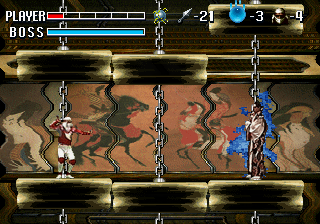

Despite being a very different game, it’s still one of the Sega Master System’s better action titles, even if they cut the ending: upon beating Nakahara you get the same “Game Over“ as you would if you’d run out of lives. Much of the music is gone and replaced with a single tune, but the huge bosses still remain, although they don’t taunt you during the stages anymore. This is actually one of the finer strategies of the game, as it allows you to stun enemies and deliver a quick killing blow. Joe’s a fragile ninja and one bullet or stab wound will kill him, sending him back to the beginning of the level, but he can still ram into enemies as long as no weapons touch him. While your primary weapon is an unlimited supply of throwing shurikens, getting close to an enemy and attacking will unleash a melee attack – either a karate punch or a sword slash, depending on your power-up – that will usually break through their defenses. Sure, you’ll be hammering that fire button to toss out as many shurikens as possible, but you’ll also have to properly time your assault, hopping on enemies while they’ve dropped their defenses.

Even more deadly are the ninjas, who appear out of nowhere in large numbers and will surround Joe if they’re not dealt with quickly. But as a game, its uninspired ideas of what constitutes amusement leave a lot to be desired.Of course, the relentless stream of bad guys makes the trek difficult – some of them mindlessly charge at you, but others hide behind boxes or block your attacks with shields. As a marketing vehicle, Shinken Yūgi faithfully captures the Segata Sanshiro spirit. But before all that, he made his video game debut in Segata Sanshir? Shinken Yūgi, a compilation of Sanshiro-themed mini-games released toward the end of the Saturn life cycle (less than a month before the Dreamcast's release). Some of these appearances are minor cameos: he made his first (albeit brief) Western debut in Sonic & All-Stars Racing Transformed, and more recently shows up as a support unit in Project X Zone 2.

So it was only a matter of time before he started showing up in video games. First appearing on television in 1997, this early Kevin Butler predecessor, with his stern attitude and goofy pompadour, quickly earned the adoration of many gamers. However, another reason for its success in Japan may have been because Segata Sanshiro kept the console's momentum going even in its later years.

Now a lot of this was because of a strong library of games (few of which were translated for international audiences) and a lack of the mismanagement that characterized the Saturn in the West. While the Sega Saturn proved unpopular among contemporary American players, the system garnered far more love in Japan.


 0 kommentar(er)
0 kommentar(er)
